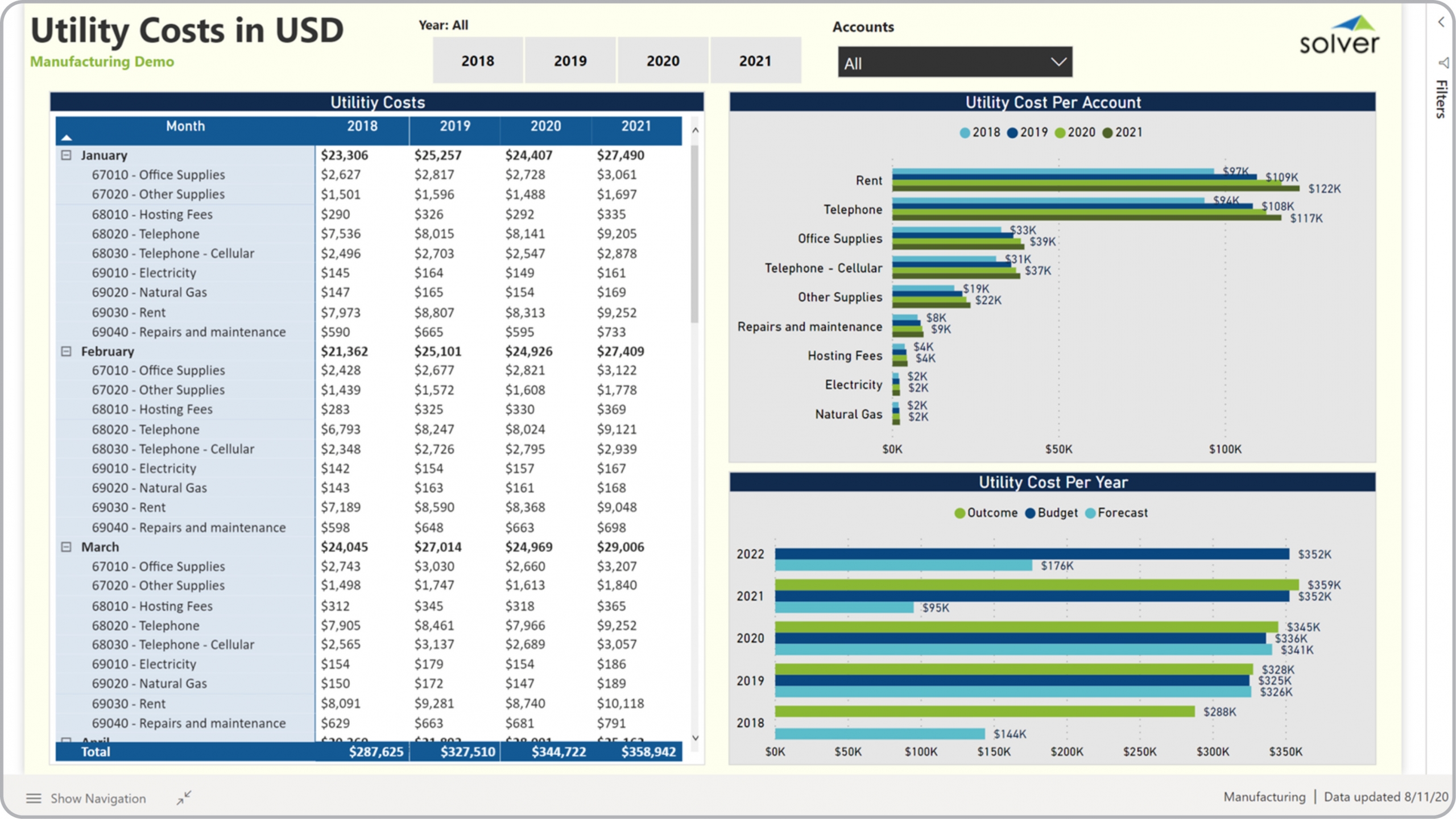Utility Cost Dashboard for Manufacturing Companies
What is a
Utility Cost Dashboard for Manufacturing Companies
? Utility Cost Dashboards are considered cost analysis tools and are used by controllers and cost accountants to track utility expenses. Some of the main functionality in this type of dashboard is that it compares expenses over months, years and GL accounts. Analysis includes: 1) Utility cost metrics by GL account by month over the last four years, 2) Utility cost by GL account with benchmarking of the last four years, and 3) Total utility cost per year for the past four years. The user can filter the dashboard on years and GL accounts. You find an example of this type of dashboard below.
Purpose of
Utility Cost Dashboards Manufacturing companies use Utility Cost Dashboards to provide managers with an easy way to compare utility expenses over a number of years. When used as part of good business practices in Financial Planning & Analysis (FP&A) departments, an organization can improve its expense control and profitability, and it can reduce the chances that managers miss any utility cost or trends.
Example of a
Utility Cost Dashboard Here is an example of a Utility Cost Dashboard with monthly and annual comparisons across General Ledger accounts. [caption id="" align="alignnone" width="2560"]
 Example of a Utility Cost Dashboard for Manufacturing Companies[/caption] You can find hundreds of additional examples
here
Who Uses This Type of
Dashboard
? The typical users of this type of dashboard are: CFOs, controllers, cost accountants, plant managers, budget managers.
Other Reports Often Used in Conjunction with
Utility Cost Dashboards Progressive Financial Planning & Analysis (FP&A) departments sometimes use several different Utility Cost Dashboards, along with profit & loss reports, cash flow reports, corporate financial dashboards, annual budgets, expense variance reports and other management and control tools.
Where Does the Data for Analysis Originate From? The Actual (historical transactions) data typically comes from enterprise resource planning (ERP) systems like: Microsoft Dynamics 365 (D365) Finance, Microsoft Dynamics 365 Business Central (D365 BC), Microsoft Dynamics AX, Microsoft Dynamics NAV, Microsoft Dynamics GP, Microsoft Dynamics SL, Sage Intacct, Sage 100, Sage 300, Sage 500, Sage X3, SAP Business One, SAP ByDesign, Acumatica, Netsuite and others. In analyses where budgets or forecasts are used, the planning data most often originates from in-house Excel spreadsheet models or from professional corporate performance management (CPM/EPM) solutions.
What Tools are Typically used for Reporting, Planning and Dashboards? Examples of business software used with the data and ERPs mentioned above are:
Example of a Utility Cost Dashboard for Manufacturing Companies[/caption] You can find hundreds of additional examples
here
Who Uses This Type of
Dashboard
? The typical users of this type of dashboard are: CFOs, controllers, cost accountants, plant managers, budget managers.
Other Reports Often Used in Conjunction with
Utility Cost Dashboards Progressive Financial Planning & Analysis (FP&A) departments sometimes use several different Utility Cost Dashboards, along with profit & loss reports, cash flow reports, corporate financial dashboards, annual budgets, expense variance reports and other management and control tools.
Where Does the Data for Analysis Originate From? The Actual (historical transactions) data typically comes from enterprise resource planning (ERP) systems like: Microsoft Dynamics 365 (D365) Finance, Microsoft Dynamics 365 Business Central (D365 BC), Microsoft Dynamics AX, Microsoft Dynamics NAV, Microsoft Dynamics GP, Microsoft Dynamics SL, Sage Intacct, Sage 100, Sage 300, Sage 500, Sage X3, SAP Business One, SAP ByDesign, Acumatica, Netsuite and others. In analyses where budgets or forecasts are used, the planning data most often originates from in-house Excel spreadsheet models or from professional corporate performance management (CPM/EPM) solutions.
What Tools are Typically used for Reporting, Planning and Dashboards? Examples of business software used with the data and ERPs mentioned above are:
- Native ERP report writers and query tools
- Spreadsheets (for example Microsoft Excel)
- Corporate Performance Management (CPM) tools (for example Solver)
- Dashboards (for example Microsoft Power BI and Tableau)
Corporate Performance Management (CPM) Cloud Solutions and More Examples
April 5, 2021
TAGS:
Reporting,
Solver,
plant,
report writer,
Microsoft,
manufacturing,
template,
practice,
Acumatica,
visualization,
Netsuite,
Finance,
planning,
GP,
dashboard,
Business Central,
excel,
ax,
forecast,
Budget,
Dynamics 365,
analysis,
budgeting,
Cloud,
Software,
Tableau,
SAP,
example,
best,
Sage,
BC,
D365,
NAV,
Intacct,
facility,
CPM,
report,
SL,
Management,
dynamics,
Power BI,
energy,
electricity

